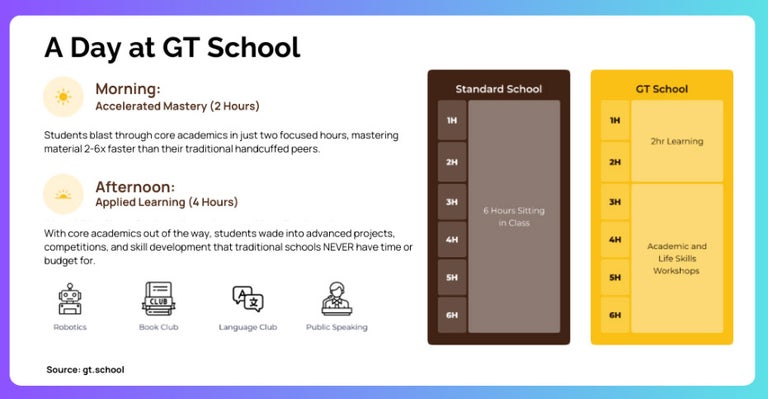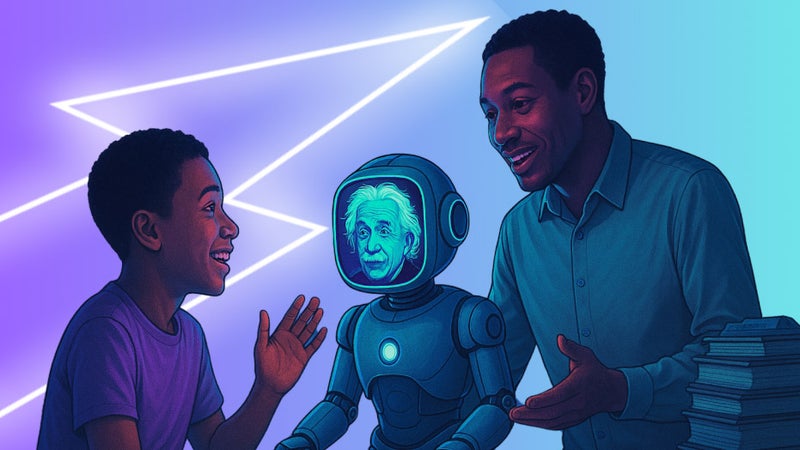Contents
- Challenge #1 – The Half-In, Half-Out Disaster
- Challenge #2 – Copy-Pasting Old Methods Into New Tech
- Challenge #3 – The Learning Silo Catastrophe
- Challenge #4 – The Data Dilemma
- Overcoming Challenges in AI Education
Are challenges in AI education being weaponized for the greatest educational heist in history? The industrial education complex is willingly withholding today's innovations from tomorrow's innovators. It's time to break the Victorian-era shackles or risk becoming complicit.
YOUR TEACHING CAREER IS OVER...
At least that's what the AI doomsayers want you to believe. Painting terrifying pictures of robot-led virtual classrooms while you - yes, YOU - join the unemployment line.
The messaging is relentless.
AI will replace teachers. Standardize education. Turn your students into screen-addicted zombies.
The fear narrative is seductive because it contains a grain of truth.
AI WILL change your role as an educator. But not in the career-ending way the panic peddlers suggest.
The Sunday evening lesson planning. Cookie-cutter feedback. Year after year repeating the same, standardized lesson script.
THAT'S what AI is coming for.
But the uniquely HUMAN side of learning - igniting curiosity, building connection, shaping *AHA moments - all remaining exclusively yours.
Here's the real truth: AI isn't your replacement. It's the assistant you've desperately needed since your first day on the job.
But - and this is crucial - there's a massive difference between having AI tools and using them well.
Dropping untamed AI into education without understanding its challenges is like throwing students into the deep end to teach swimming.
Some might figure it out. Most will struggle. Many will drown.
Your students aren't guinea pigs. And you deserve better than a trial-by-fire.
That's why we're here. We've identified the 4 BIGGEST challenges in AI education - and EXACTLY how to solve them.
Challenge #1 – The Half-In, Half-Out Disaster
Many educators today are caught in AI limbo.
Skeptical but curious. Interested but overwhelmed. Strictly dabbling.
This one-foot-in, one-foot-out approach is integration (and optimization) murder.
You don't save time. Your students don't see results.
But who could blame you? The industrial-era mentality sold us on a horror show of entrenched lies.
Your degree will last you decades. Students learn best when sitting quietly. Technology is a distraction.
Here's the reality:
- Skills half-life a century ago was 35 years. Today it's closer to 2.5
- AI-supported students learn 2.1X faster than traditional students
- 76% of students report higher engagement when leveraging technology
The industrial education complex has given teachers Stockholm Syndrome for a system that flatlined decades ago. But the corpse doesn't need to keep dragging you down.
You need FULL system buy-in. And you need it NOW.
Solution: SHOW The Win
Stop theorizing. Start experimenting.
The fastest path to genuine buy-in isn't reading articles or attending workshops. It's SEEING wins with your own eyes.
We're talking hours saved. Busywork reduced. Bigger, better results achieved.
Where should you start? Those predictable, soul-crushing administrative tasks you hate.
- Sunday night lesson planning
- Building assessments (and those awful rubrics)
- Midnight grading marathons
When you SEE AI transform these tasks from hours to minutes - WHILE improving quality - resistance fades.
AI isn't another useless checkbox on your already overflowing to-do list. It's the liberator you've been begging for.
The one that hands back the reins so you can finally deliver the impact that called you to teaching in the first place.
Challenge #2 – Copy-Pasting Old Methods Into New Tech
Here's traditional education's dirty secret: They use revolutionary technology to do exactly the same thing. Over and over and over again.
Notebooks became laptops. Chalkboards became smart boards. Worksheets became online forms.
Same exact content. Same exact approach. Just... digital.
This isn't innovation. It's the same, decades-long stagnation recreated digitally.
AI has true transformative potential - automation, hyper-personalization, AMPLIFIED human experience. But when we simply digitize the traditional, we strip AI of everything that makes it GREAT.
You don't buy a Ferrari to push it around your driveway. We need to look at teaching through fresh eyes.
Solution: Build New Systems
It's time to map your jagged frontier - that constantly shifting border between what AI handles masterfully and what remains uniquely yours.
Step 1: Identify the predictable, repetitive tasks you HATE. The cookie-cutter lesson plans. The monotonous grading. The page after page of practice problems. You know you're onto something if it turns your brain to static.
Step 2: Experiment with AI to shorten and, eventually, eliminate these tasks. Getting through them faster is Phase 1. Removing them entirely should be the goal.
Step 3: Pour your reclaimed hours into what humans do infinitely better than machines. Find new ways to spark curiosity. Build trust that has students pushing past frustration. Cultivate the fire of intrinsic motivation.
When AI handles the mechanical, you're free to unleash what makes you irreplaceable: creativity, empathy, and human connection.
Remember: AI is a tool to enhance human teaching, not replace it. The calculator didn't eliminate the need for math teachers – it freed them to teach deeper mathematical thinking.
Challenge #3 – The Learning Silo Catastrophe
Perhaps the most pervasive fear of artificial intelligence in education is classroom fragmentation.
Each student locked in their own algorithmic learning experience. Staring at their individual screen. Never connecting with their peers.
Thirty students in a room. Thirty isolated learning islands.
But here's a reality check: Forcing everyone through identical content at identical paces is MORE isolating.
Advanced learners catch on quickly, get bored, and check out. Struggling students can't keep up, get frustrated, and shut down.
It's the appearance of togetherness masking profound isolation.
Solution: Unlock Space for REAL Collaboration
AI is the great equalizer in authentic collaboration.
Don't take my word for it. Let's look at what's already happening.
GT School has cracked the code on AI-driven learning and deep-personal connection. They leverage AI to concentrate on core academics in the first half of the day. Then they redirect every hour saved towards real problem-solving and authentic collaboration.
Here's the GT Schedule at a glance:

True collaboration doesn't happen when 30 kids complete identical worksheets side-by-side. It happens when they bring their unique strengths to tackle real challenges TOGETHER.
AI doesn't isolate. It creates space for the authentic connection that industrial education can't offer.
Challenge #4 – The Data Dilemma
The scariest fact about AI in education? It requires student data to work effectively.
Learning patterns. Assignment performance. Reading levels. Conceptual struggles. Attention spans.
The more data AI has, the better it can personalize learning for each and every individual student. But this sets off alarm bells.
Who owns this data? How is it stored? Could it be misused? What about student privacy?
These are all legitimate concerns that HAVE to be thought through. But avoiding AI isn't the answer.
You don't ban cars because of potential car crashes. You build rules and processes that manage the risks.
AI is the same.
Solution: Plan Carefully, Implement Strategically
Treat student data like the valuable resource it is – something to be protected, respected, and directed.
Start with these non-negotiables:
- Clear boundaries: Explicit policies on what data is collected, when, and why
- Ironclad security: Regular audits and top-tier protection
- Transparent communication: Open dialogue with parents, students, and staff
- Ethical guidelines: Firm rules about how data can and cannot be used
Educational data ISN'T new.
Teachers have always collected information about student performance. The difference now is scale and precision.
But with proper oversight and careful implementation, AI creates a HUGE learning opportunity. Don't let fear deprive your students of better, more engaging, more personalized learning.
Demand ethical implementation. Create AI systems that serve students. NEVER compromise.
Overcoming Challenges in AI Education
Teacher sentiment toward AI jumped from just 28% positive in 2023 to 49% in 2024. The tide is turning - but that still leaves HALF of educators standing on the outside looking in.
But here's what's fascinating: The divide isn't about resistance. It's about knowledge.
When asked why they're not using AI, the top reason given by educators (62%) was just not knowing how.
Not an ethical concern. Not a philosophical opposition. Just a lack of know-how.
With a staggering 90% of instructors agreeing AI is here to stay, NOW is the time to join the party. To explore the challenges of AI in education. And start addressing them before it's too late.
Ready to embrace the future of teaching?
The challenges in AI education aren't going to solve themselves. It's time to join the AI-driven teaching elite and build your 21st Century classroom.








